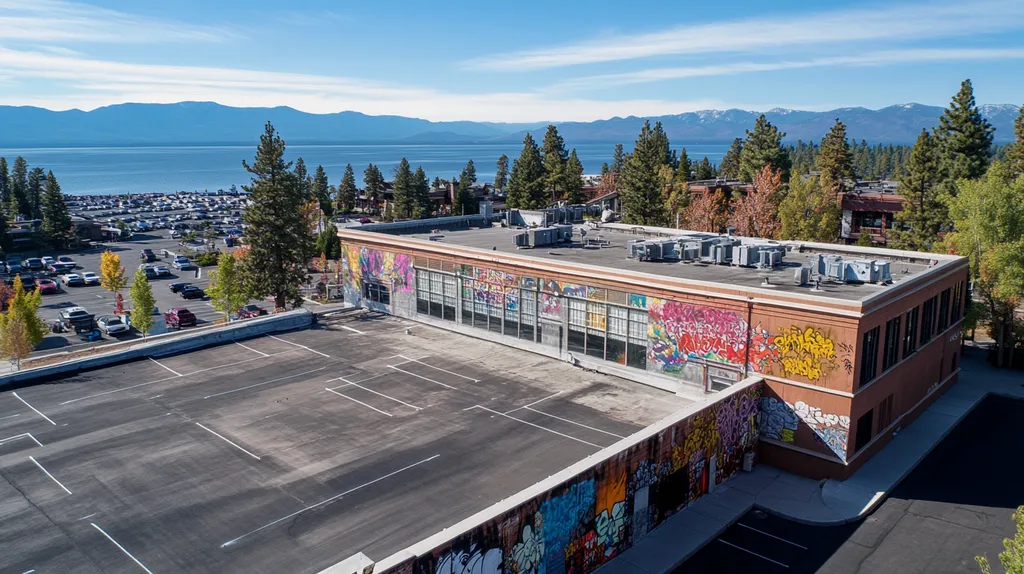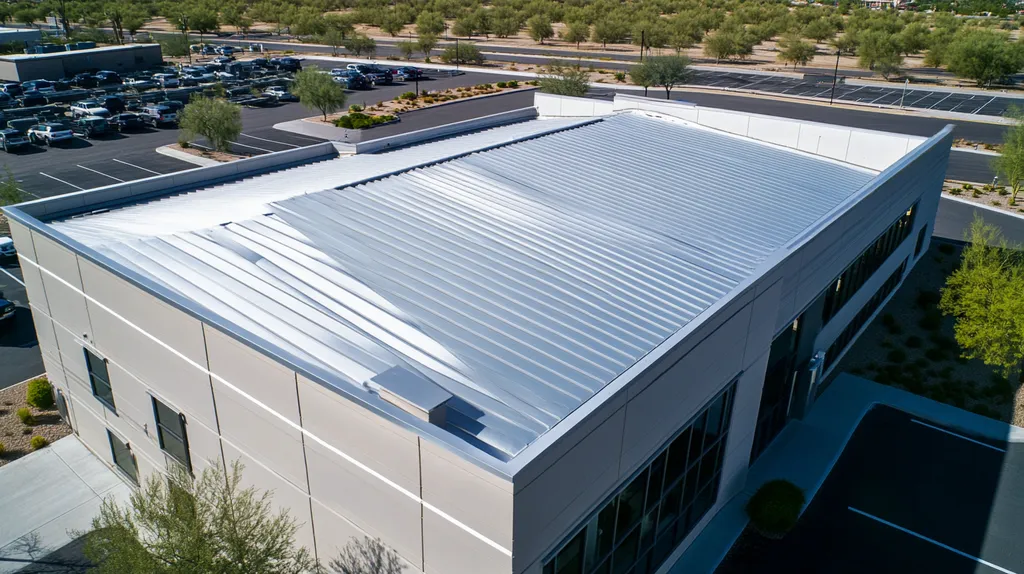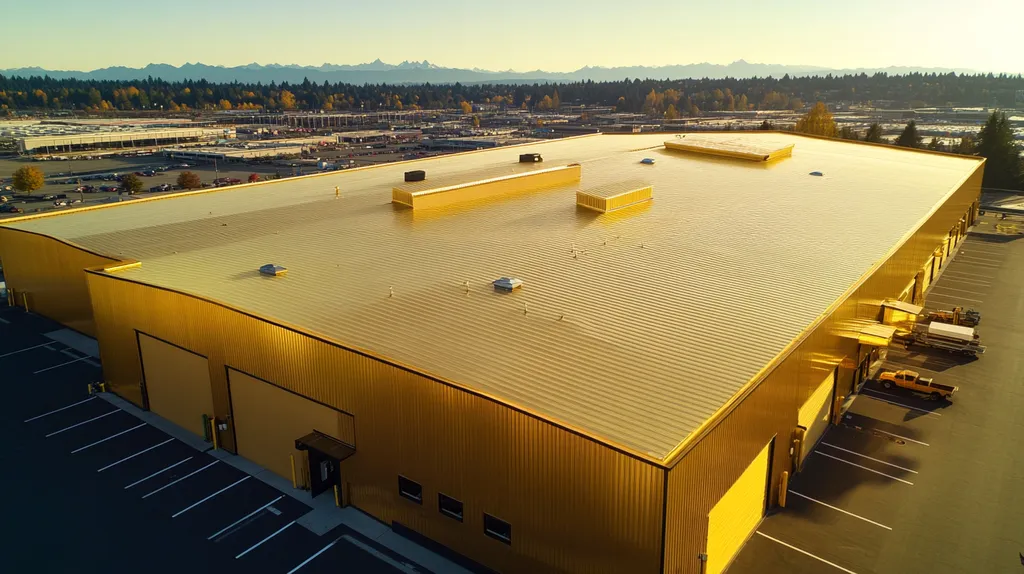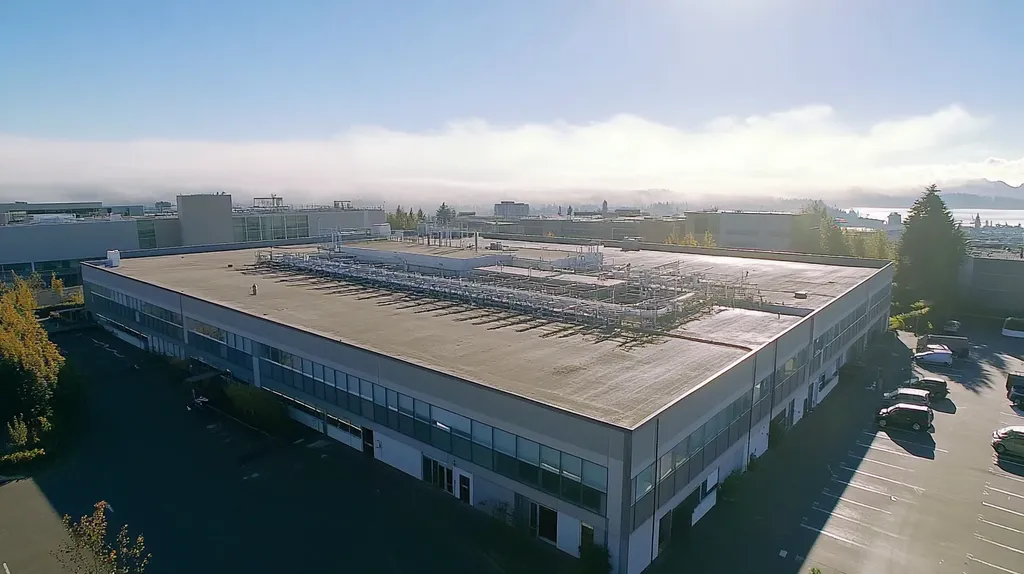Commercial property owners face a critical decision when selecting roofing materials, as the wrong choice can reduce a building’s lifespan by up to 20 years and lead to hundreds of thousands in unexpected repairs.
Studies show that 35% of all commercial roof failures occur due to poor material selection, yet many decision-makers lack clear guidance on evaluating different options.
From traditional built-up roofing to modern single-ply membranes, each material offers distinct advantages and challenges that directly impact long-term performance and cost.
This comprehensive guide examines the key factors that determine roofing material longevity, helping property professionals make informed decisions that maximize their investment while ensuring optimal building protection.
SECTION 1: PERFORMANCE FACTORS
The lifespan of a commercial roof is a crucial factor that can directly impact both property value and operational expenses. Selecting the right roofing material is key, as it determines the roof’s durability, maintenance requirements, and overall performance. Research shows that choosing the wrong material can reduce a roof’s lifespan by as much as 50%, resulting in expensive repairs and replacements down the line. Therefore, understanding the performance factors of roofing materials is essential for property professionals who want to make well-informed decisions.
Material Durability
Material durability stands as one of the most significant factors influencing how long commercial roofs last. Various materials—such as TPO, EPDM, and PVC—offer different levels of strength and longevity. For example, PVC roofs can last up to 30 years with proper installation, whereas asphalt roofs might need to be replaced in as little as 15 years.
The thickness and composition of roofing materials are crucial for durability. Thicker materials typically withstand extreme weather conditions better than their thinner counterparts. Selecting high-quality materials not only pays off in longevity but can also be a wise financial investment in the long run.
Additionally, exposure to potential hazards like hail or falling branches can affect durability. Opting for a more robust material can help protect against these risks, ultimately extending the roof’s lifespan and safeguarding the building’s interior while maintaining productivity.
Key Action Items
Weather Resistance
Weather resistance is vital for evaluating the expected lifespan of commercial roofing systems. Different materials respond differently to climate challenges, including harsh UV rays, heavy rainfall, and temperature changes. For instance, EPDM roofs excel at resisting ultraviolet rays, enhancing their longevity especially in sunny climates.
When selecting roofing material, it’s important to consider local climate conditions. A sloped metal roof can be beneficial in snowy areas, helping prevent ice accumulation that could cause damage. Conversely, flat roofs may need advanced materials designed to withstand intense rainfall.
Pooling water is a common issue seen with certain roofing types that lack sufficient weather resistance, often leading to leaks and structural compromises. However, these issues can be minimized with proper installation methods and by choosing materials specifically engineered for effective water management.
Key Action Items
Maintenance Needs
Maintenance requirements can greatly determine how long a commercial roof will last. Some roofing options, like built-up systems, necessitate more frequent inspections and services to head off leaks and deterioration. Regular maintenance is essential for catching issues early before they result in costly repairs.
In contrast, materials like TPO may demand less upkeep due to their enhanced resistance to punctures and harsh weather. Opting for low-maintenance roofing solutions can provide significant time and cost savings for property managers over the roof’s lifespan.
Additionally, it’s important to consider how maintenance tasks differ based on the roof type. A rooftop garden will require more attention for proper drainage and plant health compared to a standard flat roof.
Key Action Items
SECTION 2: FINANCIAL CONSIDERATIONS
When it comes to commercial roofing, the financial implications cannot be overlooked. Making the right choice from the start can save property owners and facility managers from costly mistakes down the line. A seemingly budget-friendly roofing option might mask hidden maintenance and energy expenses that accumulate over time. This section dives into initial installation costs, long-term maintenance expenses, and potential energy savings, all crucial for making informed financial decisions.
Initial Installation Costs
The costs associated with installing different commercial roofing materials can vary significantly, directly affecting budgets. For example, a built-up roof (BUR) can cost between $3 to $5 per square foot, whereas a premium metal roof might range from $7 to $12 per square foot. This initial investment is a major factor in the decision-making process.
Although lower-priced materials might be tempting, they often lead to more frequent repairs and replacements, incurring higher costs over time. Evaluating these initial expenses helps property professionals align their budgets while ensuring quality.
Installation processes can also affect overall costs. Some materials, like thermoplastic olefin (TPO), require less labor, which can lower installation costs. Prioritizing professional installation also plays a significant role in the longevity of the roof, ultimately affecting financial outcomes.
Key Action Items
Long-Term Maintenance Expenses
Maintenance is a significant aspect of long-term roofing costs. Choosing roofing systems with lower maintenance needs, like single-ply membranes, can result in overall savings. Regular inspections and proactive maintenance can significantly prolong the life of all roof types.
Each roofing material has specific maintenance requirements. For instance, built-up roofs often need regular sealing and checks, which can increase annual costs. Meanwhile, more durable materials, such as metal or quality asphalt shingles, typically incur fewer maintenance costs.
Failing to account for ongoing maintenance can lead to budget issues, especially if a material deteriorates prematurely. A comprehensive financial assessment must include not only installation costs but also the expected maintenance expenses throughout the roof’s lifespan.
Key Action Items
Potential Energy Savings
Energy efficiency can play a pivotal role in long-term financial returns. Reflective materials like TPO and white PVC roofs can significantly reduce cooling costs, leading to substantial savings on utility bills over time. In some cases, these energy-efficient choices may even offset higher initial costs.
Selecting materials that align with the local climate enhances energy efficiency. For instance, lighter-colored roofs in hotter regions help minimize heat absorption, reducing the need for air conditioning.
Property owners should also investigate tax incentives or rebates for energy-efficient roofing options, further lowering overall expenses. Incorporating energy performance into decision-making is vital for maximizing financial outcomes.
Key Action Items
SECTION 3: COMPLIANCE REQUIREMENTS
Compliance requirements are essential for commercial property owners and facility managers to navigate. Failing to meet these regulations can result in hefty fines, safety issues, and potentially costly retrofits. According to the National Roofing Contractors Association, up to 20% of roofing costs may stem from penalties related to regulatory non-compliance. This section explores vital building codes and standards, the significance of regulatory inspections, and the importance of environmental compliance.
Building Codes and Standards
Building codes and standards are key in ensuring roofing systems are safe, efficient, and durable. They set minimum performance requirements for materials and installation practices. For instance, the International Building Code (IBC) offers guidelines that adapt to local climates and conditions, reflecting the specific needs of each region.
Ignoring these codes can not only shorten a roof’s lifespan but also complicate its intended use. Failure to comply may lead to delays in project approvals and inspections, which can derail construction schedules. It’s crucial for property owners to familiarize themselves with the applicable codes in their area to prevent these issues.
Consulting with a knowledgeable roofing professional can provide valuable insight into local regulations. This collaborative approach helps in selecting materials and techniques that not only comply but enhance the roof’s lifespan. Adhering to these standards is a critical step toward ensuring a successful roofing project.
Key Action Items
Regulatory Inspections
Regulatory inspections are crucial in upholding the integrity and safety of commercial roofs. These inspections are mandatory at various stages of roofing projects, from pre-installation to post-completion, ensuring that the work meets established codes and standards.
Regular inspections offer the advantage of identifying potential issues early. For example, a minor defect detected during an initial inspection can prevent more severe damage and expensive repairs down the line. Skipping these inspections may keep unnoticed problems hidden, threatening the roofing system’s overall stability.
Property owners should budget for these inspections as a key component of their roofing strategy. By planning and allocating resources for regulatory checks, they can enhance compliance and extend the roof’s lifespan, saving costs in the long run.
Key Action Items
Environmental Compliance
Environmental compliance is becoming increasingly important in the roofing sector, reflecting the industry’s broader shift towards sustainability. Regulations often dictate the materials and practices that minimize waste and favor eco-friendly options. Many regions now require roofs to meet strict energy efficiency standards.
Disregarding these regulations can result in legal consequences and inflated operational costs. Properties that comply with environmental guidelines may also benefit from incentives such as tax breaks or rebates designed to support sustainable practices. Furthermore, environmentally compliant roofs typically offer superior insulation, which can help reduce energy expenses.
Investing in roofing systems that meet environmental requirements is not just a legal obligation; it presents an economic opportunity. Collaborating with qualified contractors ensures that material selections and installation methods adhere to current environmental regulations, benefiting both compliance and building performance.
Key Action Items
SECTION 4: RISK MANAGEMENT
Identifying and managing potential risks associated with commercial roofing materials is critical for property owners and facility managers. A compromised roof can lead to leaks, water damage, and even structural failure, resulting in costly repairs. Water damage claims make up more than 20% of all commercial insurance claims, underscoring the need for a robust roofing system to mitigate these risks.
Leak and Water Damage Risks
Leaks are one of the foremost dangers to the integrity of commercial roofs. A small leak can quickly spiral into extensive water damage that affects not just the roofing system but the interior spaces as well. The right maintenance should prevent leaks, but materials like EPDM rubber may still be vulnerable to punctures, especially in high-traffic zones.
Conducting routine inspections allows property managers to spot potential issues before they become serious. For example, a single missing shingle can lead to water accumulation, harming insulation and other underlying materials. Proper drainage is crucial because standing water significantly increases the chance of leaks.
Property owners should be proactive about preventing water damage since repairs can cost thousands. Investing in high-quality roofing systems can reduce exposure to leaks and extend the roof’s lifespan, while integrating moisture detection systems offers an extra layer of protection against water intrusion.
Key Action Items
Structural Integrity Concerns
Ensuring the structural integrity of a roof is essential for safety and functionality. Roofs are exposed to various environmental challenges, including snow loads, high winds, and potential impacts. A failure in these areas can lead to serious safety hazards and significant property damage.
Lightweight materials such as TPO may be easier to install but might not support heavy loads as well as traditional materials like built-up roofing. The chosen roofing material must meet the specific requirements of the building’s environment to avoid structural failures.
Regular inspections are crucial to identify problems early. For instance, damages to the underlying deck due to moisture can cause overall roof weakness. Establishing a maintenance plan focused on structural integrity can greatly extend the lifespan of the roofing system.
Key Action Items
Fire Resistance and Safety
Fire safety is an essential consideration for all commercial roofing projects. Various fire hazards can loom over roofs, from external threats such as wildfires to internal dangers stemming from electrical failures. Using fire-resistant materials like modified bitumen can enhance overall safety as opposed to using organic shingles.
Roofing materials are rated based on their fire resistance, indicating how well they withstand flame exposure. Opting for higher-rated materials, like those with a Class A rating, significantly lowers the risk of fire-related damage.
Inadequate fire safety measures can result in legal issues, making compliance with local building codes non-negotiable. Conducting regular fire safety assessments reveals risks tied to specific materials and operational practices, ensuring both property and occupant safety.
Key Action Items
SECTION 5: OPERATIONAL PROCEDURES
Establishing robust operational procedures is essential for maximizing the lifespan of commercial roofing materials. Ignoring these practices can lead to costly repairs and premature roof failures. Studies indicate that regular inspections can extend a roof’s life by up to 50 percent, making attention to these details not just beneficial but necessary. This section delves into installation best practices, regular inspection protocols, and efficient repair and replacement strategies.
Installation Best Practices
Quality installation practices are crucial for ensuring that a roof meets its performance expectations. Hiring a qualified and experienced contractor is paramount; for example, improper sealing can lead to leaks, undermining the roof’s integrity.
Strictly adhering to manufacturer guidelines cannot be overlooked. These guidelines offer critical instructions on installation techniques and material compatibility, enhancing longevity and minimizing future repair needs.
Weather conditions should also be factored into installation timing. Extreme temperatures or wet conditions can compromise the quality of work. An ideal environment ensures proper adhesion and material durability.
Finally, equipping the installation crew with thorough training is vital. Knowledgeable workers can proactively address potential issues during the installation process, reinforcing the roof’s longevity.
Key Action Items
Regular Inspection Protocols
Establishing a routine inspection protocol is essential for catching issues before they escalate. It’s advisable to conduct inspections at least twice a year, ideally in spring and fall, to identify small problems that could otherwise lead to larger risks.
Focus on areas that are particularly vulnerable to wear, such as joints and seams, as these are common leak points. Early detection of damage allows for swift repairs that can substantially extend the roof’s lifespan.
Utilizing technology can enhance the efficiency of inspections. For example, using drones equipped with cameras enables thorough checks of hard-to-reach spots, providing quality visual documentation for analysis.
Furthermore, maintaining a detailed inspection log is beneficial. This record can help identify recurring issues over time, guiding future maintenance decisions and supporting strategic budgeting.
Key Action Items
Repair and Replacement Strategies
Implementing effective repair strategies can significantly prolong a roof’s lifespan while minimizing replacement costs. Early intervention is critical; addressing minor repairs promptly can prevent them from escalating into major issues.
Understanding when to repair versus when to replace is equally important. If repairs grow frequent and costly, replacing the roof may be the more economical choice, particularly if it’s nearing the end of its expected lifespan.
Using high-quality materials during repairs is crucial for ensuring durability and compatibility with the existing roof system. This not only reinforces repairs but also extends the lifespan of the entire roofing structure.
Finally, developing a long-term replacement strategy based on the roof’s age and material can facilitate smarter budgeting, reducing surprises and maintaining building safety.
Key Action Items
SECTION 5: OPERATIONAL PROCEDURES
Establishing effective operational procedures is essential for maximizing the lifespan of commercial roofing materials. Ignoring these practices can lead to expensive repairs and premature roof failures. Research shows that regular inspections can extend a roof’s life by up to 50%. This section covers installation best practices, routine inspection protocols, and efficient repair and replacement strategies.
Installation Best Practices
High-quality installation practices are critical in ensuring roofs perform optimally. Choosing a qualified and experienced contractor is essential, as improper sealing can result in leaks that compromise the roof’s integrity.
Adherence to manufacturer guidelines is crucial; these instructions provide essential information on installation techniques and material compatibility. Following them not only enhances the roof’s longevity but also reduces the likelihood of costly repairs.
Weather conditions significantly impact installation quality. Performing installations during extreme temperatures or wet conditions can jeopardize the materials’ adhesion. Ensuring favorable conditions is key to achieving durable roofing.
Lastly, thorough training for the installation crew cannot be overlooked. Workers who are well-informed about potential issues can proactively address concerns, thereby enhancing the roof’s lifespan.
Key Action Items
Regular Inspection Protocols
Implementing a routine inspection protocol is vital for identifying potential issues before they escalate. It is recommended to conduct inspections at least twice a year, ideally in spring and fall, to catch small problems that could lead to larger risks.
During inspections, focus on areas prone to wear, such as joints and seams, which are common points for leaks. Early detection of damage allows for prompt repairs that can significantly extend the roof’s lifespan.
Utilizing technology can streamline the inspection process. Drones equipped with cameras can safely inspect hard-to-reach areas, providing high-quality visual documentation for thorough analysis.
Maintaining a detailed inspection log is also beneficial. This record helps identify patterns over time, guiding future maintenance decisions and supporting effective budgeting.
Key Action Items
Repair and Replacement Strategies
Effective repair strategies can significantly prolong a roof’s lifespan while minimizing replacement costs. Timely intervention is essential; addressing minor repairs quickly can prevent more extensive issues from developing. For instance, repairing small leaks can save substantial costs in potential damage.
Knowing when to repair versus when to replace is also crucial. Frequent repairs may signal that replacing the roof is a more economical choice, especially as it nears the end of its expected lifespan.
Using high-quality materials for repairs is vital for ensuring durability and compatibility with the current roof system. This focus on quality not only reinforces repairs but also extends the overall lifespan of the roofing structure.
Lastly, consider formulating a long-term replacement strategy based on the roof’s age and material. Planning for eventual replacements enables proactive budgeting, reducing surprises while maintaining building safety.
Key Action Items
The Bottom Line
With commercial roofing materials costing $5-15 per square foot and premature failures resulting in 35% higher lifetime expenses, selecting the right roofing system is a critical business decision.
Property owners must carefully evaluate material durability, weather resistance, and maintenance requirements when choosing between options like TPO, EPDM, or built-up systems.
Regular inspections, proper installation, and preventive maintenance can extend a roof’s lifespan by up to 50%, generating significant cost savings over time.
Understanding local building codes, environmental regulations, and safety requirements is essential for avoiding expensive penalties and ensuring long-term performance.
By following established best practices and implementing thorough operational procedures, facility managers can maximize their roofing investment while protecting their property for decades to come.
FREQUENTLY ASKED QUESTIONS
Q. What performance factors affect commercial roof lifespan?
A. The lifespan of a commercial roof is influenced by material durability, weather resistance, and maintenance needs. Choosing high-quality materials and regular inspections can prolong the life of a roof and prevent costly failures. Understanding local climate challenges is also crucial for selecting the best roofing options.
Q. How do initial costs impact commercial roof decisions?
A. Initial installation costs of commercial roofs vary widely, affecting budget considerations. Sometimes, lower-cost materials might lead to higher long-term maintenance expenses, so it’s vital to balance upfront expenses with future costs. Evaluating the total cost of ownership is key to making a sound financial decision.
Q. What are the compliance requirements for a commercial roof?
A. Compliance with local building codes and regulations is essential for commercial roofing. These rules ensure the materials and installation practices meet safety and performance standards. Failing to adhere to these requirements can lead to fines and project delays, underscoring the importance of thorough compliance checks.
Q. How can I manage risks associated with an industrial roof?
A. Risk management involves regular inspections to identify leaks and structural issues early. Understanding the limitations of each material also helps prevent hazardous situations. Employing high-quality materials and proper drainage systems can diminish the risks of water damage and enhance overall roof longevity.
Q. What operational procedures can maximize a commercial roof’s lifespan?
A. Establishing effective operational procedures like hiring qualified contractors and adhering to manufacturer’s guidelines can enhance roofing performance. Implementing a schedule for regular inspections, documenting repairs, and promptly fixing minor issues are key practices to reach optimal lifespan and avoid costly replacements.
Q. What are essential repair strategies for an industrial roof?
A. Effective repair strategies include promptly addressing minor issues before they escalate. It’s crucial to utilize high-quality materials for repairs and document all actions for future reference. Regular assessment can help property managers determine whether repairs or replacement is the more economical choice in the long run.
Q. How do environmental regulations affect commercial roofing choices?
A. Environmental regulations increasingly dictate roofing material choices, focusing on sustainability and energy efficiency. Compliance with these standards can yield financial benefits such as tax incentives and rebates. Selecting environmentally compliant materials enhances overall building performance while supporting efforts to mitigate environmental impact.










